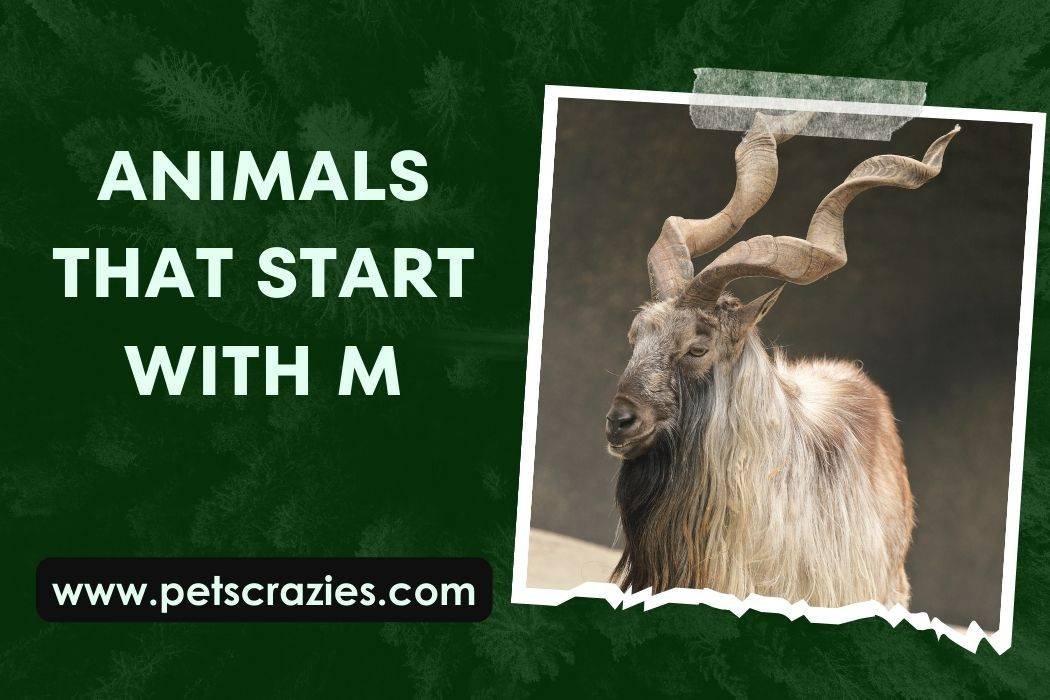Have you ever found yourself scratching your head, trying to think of animals that start with the letter ‘M’? It’s a surprisingly tricky task, isn’t it? The animal kingdom is vast and varied, but when we zero in on a specific letter, like ‘M’, our minds often draw a blank.
Maybe it’s because we’re more tuned to animal names in general, rather than alphabetically. But here’s the fun part: once you start listing them, it’s like a light bulb goes off.
List Of Animals That Start With M
- Macaw
- Meerkat
- Moose
- Mongoose
- Manatee
- Marmoset
- Mole
- Mallard
- Mandrill
- Magpie
- Manta Ray
- Minke Whale
- Muskox
- Macaque
- Marmot
- Mayfly
- Moray Eel
- Monarch Butterfly
- Mudskipper
- Mynah Bird
- Mountain Goat
- Mudpuppy
- Moth
- Monitor Lizard
- Musk Deer
- Megalodon (extinct)
- Mastodon (extinct)
- Mammoth (extinct)
- Markhor
- Margay Cat
Animals That Start With M (Fun Facts & Species Details)
1. Macaw

Fun Fact: Macaws are known for their vibrant plumage and their ability to mimic human speech.
| Detail | Information |
| Scientific Name | Ara |
| Origin | Central and South America |
| Family | Psittacidae |
2. Meerkat

Fun Fact: Meerkats are highly social animals and live in groups called ‘mobs’ or ‘gangs’.
| Detail | Information |
| Scientific Name | Suricata suricatta |
| Origin | Southern Africa |
| Family | Herpestidae |
3. Moose

Fun Fact: Moose are the largest of all the deer species, and their antlers can spread up to six feet from end to end.
| Detail | Information |
| Scientific Name | Alces alces |
| Origin | North America and Eurasia |
| Family | Cervidae |
4. Mongoose

Fun Fact: Some species of mongoose are known for their remarkable ability to fight and kill venomous snakes.
| Detail | Information |
| Scientific Name | Herpestidae |
| Origin | Africa, Southern Asia, and the Iberian Peninsula |
| Family | Herpestidae |
5. Manatee

Fun Fact: Manatees are also known as ‘sea cows’ and can consume about 10-15% of their body weight in vegetation daily.
| Detail | Information |
| Scientific Name | Trichechus |
| Origin | Caribbean, Amazon Basin, West Africa |
| Family | Trichechidae |
6. Marmoset

Fun Fact: Marmosets are one of the smallest monkeys and communicate using a complex system of vocalizations.
| Detail | Information |
| Scientific Name | Callitrichidae |
| Origin | South America |
| Family | Callitrichidae |
7. Mole

Fun Fact: Moles are adapted to a subterranean lifestyle with their powerful forelimbs and large paws designed for digging.
| Detail | Information |
| Scientific Name | Talpidae |
| Origin | North America, Europe, Asia |
| Family | Talpidae |
8. Mallard

Fun Fact: Mallards are the most abundant and widespread of all waterfowl; every duck has descended from this species.
| Detail | Information |
| Scientific Name | Anas platyrhynchos |
| Origin | Northern Hemisphere |
| Family | Anatidae |
9. Mandrill

Fun Fact: Mandrills are the world’s largest monkeys and are known for their colorful faces and rumps.
| Detail | Information |
| Scientific Name | Mandrillus sphinx |
| Origin | Western Central Africa |
| Family | Cercopithecidae |
10. Magpie

Fun Fact: Magpies are considered one of the most intelligent animals and are capable of recognizing themselves in a mirror.
| Detail | Information |
| Scientific Name | Pica pica |
| Origin | Europe, Asia, Western North America |
| Family | Corvidae |
11. Manta Ray
Fun Fact: Manta rays are the largest type of ray in the world, with some species having a wingspan of up to 29 feet.
| Detail | Information |
| Scientific Name | Manta |
| Origin | Tropical, subtropical, and temperate waters worldwide |
| Family | Mobulidae |
12. Minke Whale
Fun Fact: Minke whales are the second smallest baleen whale, yet they can perform very high and long jumps out of the water.
| Detail | Information |
| Scientific Name | Balaenoptera acutorostrata |
| Origin | Global oceans |
| Family | Balaenopteridae |
13. Muskox
Fun Fact: Muskoxen have a thick coat and a strong smell, which is used to attract mates during the mating season.
| Detail | Information |
| Scientific Name | Ovibos moschatus |
| Origin | Arctic regions in North America and Greenland |
| Family | Bovidae |
14. Macaque
Fun Fact: Macaques are known for their high intelligence and some species are famous for their ability to use tools.
| Detail | Information |
| Scientific Name | Macaca |
| Origin | Asia, North Africa, and Gibraltar |
| Family | Cercopithecidae |
15. Marmot
Fun Fact: Marmots are known for their loud whistles to warn others of predators, earning them the nickname “whistle pig.”
| Detail | Information |
| Scientific Name | Marmota |
| Origin | North America, Europe, and Asia |
| Family | Sciuridae |
16. Mayfly
Fun Fact: Mayflies have one of the shortest lifespans of any animal; some species live for only 24 hours.
| Detail | Information |
| Scientific Name | Ephemeroptera |
| Origin | Worldwide |
| Family | Multiple families |
17. Moray Eel
Fun Fact: Moray eels have a second set of jaws in their throat called pharyngeal jaws, which they use to pull prey down their throats.
| Detail | Information |
| Scientific Name | Muraenidae |
| Origin | Worldwide in tropical and temperate seas |
| Family | Muraenidae |
18. Monarch Butterfly
Fun Fact: Monarch butterflies are known for their incredible mass migration, traveling thousands of miles from North America to central Mexico.
| Detail | Information |
| Scientific Name | Danaus plexippus |
| Origin | North, Central, and South America |
| Family | Nymphalidae |
19. Mudskipper
Fun Fact: Mudskippers are fish that can walk on land using their pectoral fins and can breathe through their skin and the lining of their mouth.
| Detail | Information |
| Scientific Name | Various species within the subfamily Oxudercinae |
| Origin | Indo-Pacific region |
| Family | Gobiidae |
20. Mynah Bird
Fun Fact: Mynah birds are among the best mimics in the world of birds, able to imitate human speech and other sounds.
| Detail | Information |
| Scientific Name | Gracula and Acridotheres |
| Origin | Southeast Asia, Madagascar, and the Comoro Islands |
| Family | Sturnidae |
21. Mountain Goat
Fun Fact: Mountain goats are not true goats but are closely related. They are excellent climbers, often resting on rocky cliffs that predators cannot reach.
| Detail | Information |
| Scientific Name | Oreamnos americanus |
| Origin | North America |
| Family | Bovidae |
22. Mudpuppy
Fun Fact: Mudpuppies are one of the few salamanders that make noise, a dog-like barking sound, which is how they got their name.
| Detail | Information |
| Scientific Name | Necturus maculosus |
| Origin | North America |
| Family | Proteidae |
23. Moth
Fun Fact: Some moths don’t have stomachs. When they transform into moths from caterpillars, they lose their mouths and digestive systems.
| Detail | Information |
| Scientific Name | Lepidoptera (order) |
| Origin | Worldwide |
| Family | Multiple families |
24. Monitor Lizard
Fun Fact: The Komodo dragon, a type of monitor lizard, is the largest living species of lizard, capable of growing up to 10 feet in length.
| Detail | Information |
| Scientific Name | Varanus (genus) |
| Origin | Africa, Asia, and Oceania |
| Family | Varanidae |
25. Musk Deer
Fun Fact: Unlike true deer, musk deer do not have antlers. Instead, they have long canine teeth that protrude from the mouth.
| Detail | Information |
| Scientific Name | Moschus (genus) |
| Origin | Asia |
| Family | Moschidae |
26. Megalodon (extinct)
Fun Fact: The Megalodon was one of the largest and most powerful predators in vertebrate history, with estimates of its size up to 60 feet.
| Detail | Information |
| Scientific Name | Carcharocles megalodon |
| Origin | Worldwide oceans |
| Family | Otodontidae |
27. Mastodon (extinct)
Fun Fact: Mastodons were prehistoric relatives of elephants, known for their long, curved tusks and conical teeth.
| Detail | Information |
| Scientific Name | Mammutidae (family) |
| Origin | North America and Eurasia |
| Family | Mammutidae |
28. Mammoth (extinct)
Fun Fact: Woolly mammoths had long, curved tusks and a coat of long hair, which helped them survive the Ice Age conditions.
| Detail | Information |
| Scientific Name | Mammuthus (genus) |
| Origin | Northern Hemisphere |
| Family | Elephantidae |
29. Markhor
Fun Fact: The markhor is known for its impressive twisted horns, which can grow up to 1.5 meters long in males.
| Detail | Information |
| Scientific Name | Capra falconeri |
| Origin | Central Asia |
| Family | Bovidae |
30. Margay Cat
Fun Fact: Margay cats are skilled climbers, and they can even hang from branches with one hind foot.
| Detail | Information |
| Scientific Name | Leopardus wiedii |
| Origin | Central and South America |
| Family | Felidae |





